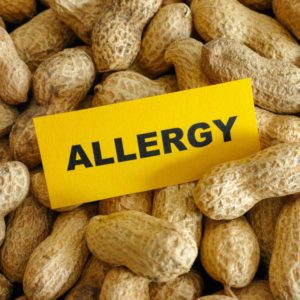
Imagine if there was something to help prevent your child’s life-threatening reaction to peanuts. New research may actually have a solution for peanut allergy desensitization.
If you have a child with a peanut allergy or any allergy, you are likely all too familiar with the stress of packing their food and closely monitoring everywhere they go – always worried about accidental ingestion of the allergen. Only about 20% of children outgrow their peanut allergy, so the challenge is ongoing for most families. (1) However, new research is uncovering a potential solution for peanut allergy desensitization. Let’s see how it works.
What is a food allergy?
A food allergy is identified when a person’s immune system overreacts to an otherwise harmless food protein by producing antibodies called Immunoglobulin E (IgE). These antibodies travel to cells that release chemicals, causing an allergic reaction when exposed to the food. (2) Even very small amounts of a food can trigger this allergic reaction, and symptoms can range from mild rashes or stomach discomfort to life-threatening anaphylaxis. (3)
What is allergy immunotherapy?
Allergy immunotherapy is built off of the idea that gradually introducing the body to small amounts of an allergen can make the immune system less sensitive to that allergen. (4) This idea has been explored in medical settings and multiple scientific studies. The approach is to target the peanut allergy by introducing small amounts of peanut protein through different pathways. These include oral immunotherapy (taken by mouth), sublingual immunotherapy (under the tongue), and epicutaneous immunotherapy (under the skin).
So, what’s in the pipeline for peanut allergy desensitization?
The product that is closest to being released to the public is an oral peanut-allergy immunotherapy treatment. The pivotal study that examined this drug was published in the November 2018 issue of New England Journal of Medicine. Results showed that 2 out of 3 patients were able to tolerate two peanut kernels after one year of taking a daily dose equivalent to one peanut kernel. The therapy is closely monitored by a medical professional and conditions the immune system to tolerate peanut proteins in small amounts to protect against accidental exposures. This was a study conducted at 66 different sites in North America and 10 countries in Europe. It is different from other studies that examined oral immunotherapy in the past because it did not allow the use of medical prophylaxis such as an antihistamine. (5)
Q & A with Dr. Thomas Casale
We spoke with Dr. Thomas Casale, the Professor of Internal Medicine and Professor of Pediatrics at the University of South Florida, Chief Medical Advisor for FARE, and an author of the study published in the New England Journal of Medicine, to learn more about allergy immunotherapy.
Q: How soon do you think this therapy will become widely adopted by practicing allergists if it receives FDA approval later this year?
A: There are already many allergists doing oral immunotherapy for peanut as well as other food allergies. However, they are not using standardized products or in many cases, standardized protocols. Most allergists have indicated that they are awaiting FDA approval of a standardized product such as the one studied, AR101. It is hoped that by the end of this year, or early next year, this product will indeed be approved by the FDA and integrated into practice.
Q: As parents of children with peanut allergies, what should we be mindful of when approaching this new therapy with our allergist or doctor?
A: This is not an easy protocol to follow. One starts at an extremely low dose of peanut and very gradually, typically every 2 weeks, increases the dose of peanut product until maintenance is achieved. The maintenance dose is typically equivalent to one or 2 peanut kernels. It is therefore important for parents and patients to remember that they will likely be protected against many accidental exposures, but they will not be able to eat large quantities of peanut. In addition, the oral immunotherapy was associated with side effects, especially those related to the gastrointestinal tract such as abdominal pain, nausea, and diarrhea. This should only be used by parents and patients willing to commit to the therapy under the guidance of an experienced allergist.
Working with a dietitian to avoid accidental exposure can also provide additional support. It is key for patients and their families to be aware of the contents of various foods in restaurants and at home. Reading food labels is an essential part of avoidance.
Q: Do you have any insights on what parents could look forward to in developments in allergy immunotherapy in the next few years?
A: There are many attempts to provide better and safer alternatives to ingestion of what one is allergic to, such as AR101. The other peanut therapy that is furthest along is the epicutaneous immunotherapy where one wears a patch with small amounts of the peanut protein on the skin. This has also shown to provide some protection against peanut allergy. There are ongoing studies to determine whether pretreatment or concomitant treatment with anti-bodies to IgE, such as omalizumab, or to IL-4 and IL-13, such as dupilumab, might provide some protection against adverse events occurring during up-dosing of the peanut product. It is hoped that it will also provide a better therapeutic outcome as well.
In summary, we have made a lot of progress, but there is much to be done. Studies showing the prevention of peanut allergy in high-risk infants treated with peanut are a major step forward. Prevention, of course, is the ultimate goal. With the advent of new Biologics, many new therapies will likely be studied and developed over the next decade.
Test Your Nutrition Knowledge
- T or F: I should give my child small doses of foods if he/she is allergic to peanuts to cure the allergy.
- T or F: There are multiple FDA approved treatments for peanut allergy.
Bio: Amy Chen, MS, RD, CDE is a registered dietitian in the San Francisco Bay Area. She enjoys writing, spending time with her family, and finding easy recipes.









